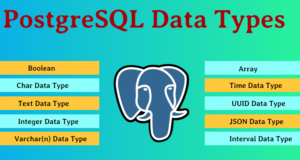

- #POSTGRESQL TUTORIAL DATA FILE PDF#
- #POSTGRESQL TUTORIAL DATA FILE .EXE#
- #POSTGRESQL TUTORIAL DATA FILE INSTALL#
- #POSTGRESQL TUTORIAL DATA FILE DRIVER#
- #POSTGRESQL TUTORIAL DATA FILE PASSWORD#
#POSTGRESQL TUTORIAL DATA FILE INSTALL#
You may need to install the build-essential package in order to compile the tutorial programs. PostgreSQL, or Postgres, is a relational database management system that provides an implementation of the SQL querying language. If you want to export a large database and generate a smaller dump file. Programming languages are available as well. Backing up PostgreSQL data is one of the most important tasks for any database. Graphical user interfaces and bindings for many Triggers, user-defined types and functions, outer joins, multiversionĬoncurrency control. Some of the features are:ĪCID transactions, foreign keys, views, sequences, subqueries, To be extensible by users in many aspects. It supports a large part of the SQL standard and is designed PostgreSQL is a fully featured object-relational database management This metapackage always depends on the currently supported PostgreSQL database documentation package. Maintainer: Debian PostgreSQL Maintainers ĭescription-en: documentation for the PostgreSQL database management system Its now possible to configure data sources using config files with Grafanas provisioning system. Here is the package information from 'apt-cache': $ apt-cache show postgresql-doc Since Mint is Debian based, it's likely the package and file locations are the same. I'm running postgresql-10, so the documentation matches the installed version. The tutorials are installed into the following directory: /usr/share/doc/postgresql-doc-10/tutorial
#POSTGRESQL TUTORIAL DATA FILE PASSWORD#
Password: Enter the password that you used when creating the Amazon RDS database.In my Debian "Buster" installation, the tutorials are included in the postgresql-doc package.In this tutorial, it is ' masterUsername.' Username: Type in the username you created for the Amazon RDS database.For example, our URL could be jdbc:postgresql://./myDatabase. Finally, append a forward slash and the name of your data base instance to the end of the URL. Enter or paste the endpoint (including port) of the DB Instance after "jdbc:postgresql://". Prepare a virtual machine (we will use AWS EC2) with an additional disk to store data, install Docker to run containers, and ZFS to enable copy-on-write for. URL: You can find your JDBC URL on the Amazon RDS console as shown in the screenshot to the right.
#POSTGRESQL TUTORIAL DATA FILE DRIVER#
In the next dialog box, click the folder icon and select the driver you downloaded in the previous step. Note: When you select a driver from the drop-down menu you will be prompted to edit the driver definition.
#POSTGRESQL TUTORIAL DATA FILE PDF#
See the PDF file included in the download for details.ī. PostgreSQL Quick Guide - PostgreSQL is a powerful, open source object-relational database system.
#POSTGRESQL TUTORIAL DATA FILE .EXE#
exe file (Windows) or the shell script (macOS, Linux) included in the download folder. Note: You can launch the application using the. The method to load a file into a table is called. Instead of creating the query and then running it through execute () like INSERT, psycopg2, has a method written solely for this query.

It takes in a file (like a CSV) and automatically loads the file into a Postgres table. After you have completed your download, install SQL Workbench. The Postgres command to load files directy into tables is called COPY. It is used to store data securely supporting best practices, and allow. In this step, we will connect to the database you created using SQL Workbench.Ī. PostgreSQL is an ORDBMS Open-Source Object-Relational Database Management System. For more information, see Viewing DB Instance Metrics. Enabling enhanced monitoring will give you metrics in real time for the operating system (OS) that your DB instance runs on. For more information about Performance Insights, a database performance and monitoring feature, see the Performance Insights web page.Įnhanced monitoring: Select Enable enhanced monitoring. Select Disable Performance Insights for this tutorial.

Option group: This option is not available in the Free Tier.For more information, see Working with DB Parameter Groups. DB parameter group : Leave the default value.If you do not provide a name, Amazon RDS will not automatically create a database on the DB instance you are creating. Database name: Type a database name that is 1 to 64 alphanumeric characters.In the Additional Configurations section: pgtblspc is a directory inside the PostgreSQL data directory, which contains symbolic links to all the tablespace locations (or on NTFS, junction points for.


 0 kommentar(er)
0 kommentar(er)
